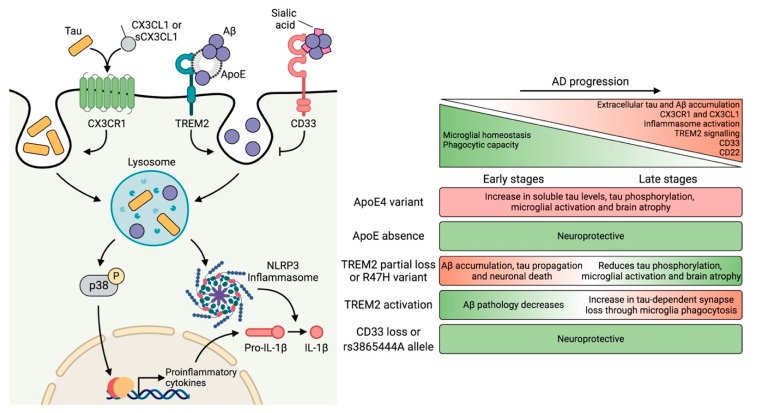Figure 2.
Overview of microglial receptors involved in neuroinflammation. Amyloid-β peptide (Aβ) and tau accumulate in the extracellular space during Alzheimer’s disease (AD). At the same time, CX3CR1 (fractalkine receptor) and CX3CL1 (fractalkine) levels increase, which compromises this communication axis, thus altering microglial homeostasis. Moreover, the increasing levels of CD33 and CD22 reduce the phagocytic capacity of these cells. In the extracellular space, tau competes with CX3CL1 for its binding to CX3CR1, a receptor involved in tau internalization. Moreover, Aβ directly interacts with triggering receptor expressed on myeloid cells 2 (TREM2) or through apolipoprotein E (ApoE), promoting its phagocytosis. Conversely, Aβ can also bind to CD33 via sialic acid residues, thereby preventing phagocytosis. It has been described that tau binds to ApoE and that tau aggregates contain sialic acid residues. However, the interaction of tau with these receptors has not yet been described. Both Aβ and tau promote the activation of the p38 Mitogen-activated protein kinase (MAPK) pathway and the NOD-, LRR-, and pyrin domain-containing 3 (NLRP3) inflammasome, which trigger the production of proinflammatory cytokines. The table on the right summarizes the effects of genetic variants highly expressed in microglia that confer susceptibility to AD. The absence of ApoE and CD33 confers neuroprotection. In contrast, the effects of TREM2 depend on the stage of the disease. For this reason, promoting TREM2 activation is effective in the preclinical phase against Aβ pathology. However, at advanced stages, TREM2 signaling is detrimental as it facilitates the progression of the disease in the context of tau pathology. AD: Alzheimer’s disease, ApoE: apolipoprotein E, Aβ: amyloid-β, CD: cluster of differentiation, CX3CL1: fractalkine, CX3CR1: fractalkine receptor, IL-1β: interleukin-1β, NLRP3: NOD-, LRR-, and pyrin domain-containing 3, Pro-IL-1β: interleukin-1β (inactive precursor), sCX3CL1: soluble fractalkine, TREM2: triggering receptor expressed on myeloid cells 2. Created with BioRender.com.

